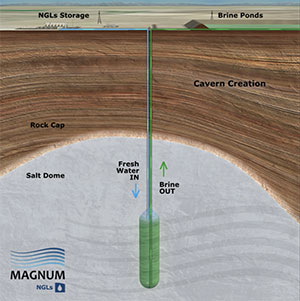Geosynthetic Composite Liners for Brine Ponds
serving the NATURAL GAS STORAGE industry
 Natural gas is colorless, odorless, and a gaseous hydrocarbon that is most commonly stored underground, and under pressure, in three types of facilities. These are: (1) depleted reservoirs in oil and/or gas fields, (2) aquifers, and (3) salt cavern formations. According to the U.S. Federal Energy Regulatory Commission (FERC), depleted oil and gas reservoirs account for 87% of the total storage capacity, aquifers (10%), and the remaining 3% using salt caverns.
Natural gas is colorless, odorless, and a gaseous hydrocarbon that is most commonly stored underground, and under pressure, in three types of facilities. These are: (1) depleted reservoirs in oil and/or gas fields, (2) aquifers, and (3) salt cavern formations. According to the U.S. Federal Energy Regulatory Commission (FERC), depleted oil and gas reservoirs account for 87% of the total storage capacity, aquifers (10%), and the remaining 3% using salt caverns.
Specific to the use of salt caverns, the industry uses water to control the flow of the natural gas to and from the salt cavern. Pumping freshwater into the cavern pushes the natural gas out, while extracting the brine water draws the natural gas into the cavern for storage.
The resulting brine water (water that is part salt) is stored above ground in ponds referred to as as brine ponds. To protect the brine water that is stored above-ground from possibly leaching into the soil, ESI installs advanced double-lined geosynthetic systems. A typical geosynthetic system may consist of a geocomposite placed directly over a subgrade, a secondary HDPE geomembrane, a geonet drainage layer topped with a conductive HDPE primary geomembrane liner. The conductive properties of the primary liner permits the ability to quickly identify and remediate pinholes in the geomembrane that may cause leaks.
Construction quality assurance (CQA) by a third-party during and after construction ensures that the project is completed as designed.
Industry References & Resources:
- American Gas Association: Representing companies delivering natural gas, AGA’s mission is to serve as the leading voice in promoting the safe, reliable, and efficient delivery of natural gas to homes and businesses across the nation.
- Interstate Natural Gas Association of America (INGAA): A trade organization that advocates regulatory and legislative positions of importance to the natural gas pipeline industry in North America.
- Natural Gas Supply Association (NGSA): NGSA represents suppliers that produce and market natural gas.
- Gas Technology Institute: GTI is the leading research, development and training organization addressing energy and environmental challenges to enable a secure, abundant, and affordable energy future.
- U.S. Energy Information Administration (EIA): Find statistics on prices, exploration & reserves, production, imports, exports, storage and consumption of natural gas.
- U.S. Federal Energy Regulatory Commission (FERC) for Natural Gas: An independent agency that regulates the interstate transmission of electricity, natural gas, and oil. FERC also reviews proposals to build liquefied natural gas (LNG) terminals and interstate natural gas pipelines.
- NaturalGas.org: Informational website for natural gas education
